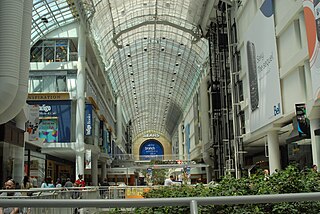
A shopping center in American English, shopping centre in Commonwealth English, shopping complex, shopping arcade, shopping plaza, or galleria, is a group of shops built together, sometimes under one roof.

Victor David Gruen, born Viktor David Grünbaum, was an Austrian-American architect best known as a pioneer in the design of shopping malls in the United States. He is also noted for his urban revitalization proposals, described in his writings and applied in master plans such as for Fort Worth, Texas (1955), Kalamazoo, Michigan (1958) and Fresno, California (1965). An advocate of prioritizing pedestrians over cars in urban cores, he was also the designer of the first outdoor pedestrian mall in the United States, the Kalamazoo Mall.
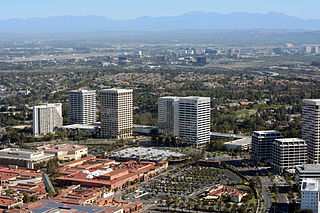
Fashion Island is an outdoor regional shopping mall in Newport Beach, California. Opened in 1967 by The Irvine Company as the anchor to their master-planned Newport Center district, Fashion Island is anchored by Bloomingdale's, Macy's, Neiman Marcus, and Nordstrom.
Ohrbach's was a moderate-priced department store with a merchandising focus primarily on clothing and accessories. From its modest start in 1923 until the chain's demise in 1987, Ohrbach's expanded dramatically after World War II, and opened numerous branch locations in the New York and Los Angeles metropolitan areas. Its original flagship store was located on Union Square in New York City. It maintained administrative offices in Newark and in Los Angeles. The retailer closed the Newark offices in the 1970s. Paul László designed the Union Square store as well as many of their other stores.

Southdale Center is a shopping mall located in Edina, Minnesota, a suburb of the Twin Cities. It opened in 1956 and is the first fully enclosed, climate-controlled shopping mall in the United States. Southdale Center has 1,297,608 square feet of leasable retail space, and contains 106 retail tenants. The mall is owned by Simon Property Group and the anchor stores are Macy's, Dave & Buster's, AMC Theatres, Hennepin Service Center, and Life Time Athletic.
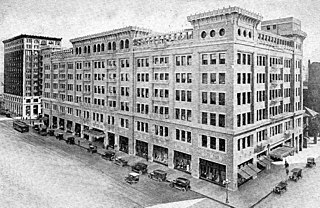
J. W. Robinson Co., Robinson's, was a chain of department stores operating in the Southern California and Arizona area, previously with headquarters in Los Angeles, California.

Bullock's was a chain of full-line department stores from 1907 through 1995, headquartered in Los Angeles, growing to operate across California, Arizona and Nevada. Bullock's also operated as many as seven more upscale Bullocks Wilshire specialty department stores across Southern California. Many former Bullock's locations continue to operate today as Macy's.

Northland Center was an enclosed shopping mall on an approximately 159-acre (64 ha) site located near the intersection of M-10 and Greenfield Road in Southfield, Michigan, an inner-ring suburb of Detroit, Michigan, United States. Construction began in 1952 and the mall opened on March 22, 1954. Northland was a milestone for regional shopping centers in the United States. Designed by Victor Gruen, the mall initially included a four-level Hudson's with a ring of stores surrounding it. As originally built, it was an open air pedestrian mall with arrayed structures. The mall was enclosed in 1975 and expanded several times in its history. Additions included five other department store anchors: J. C. Penney in 1975, MainStreet in 1985, and TJ Maxx, Target, and Montgomery Ward in the 1990s. Managed by Spinoso Real Estate Group, Northland Center featured approximately 100 stores. Macy's, the last anchor, closed on March 22, 2015, exactly 61 years to the date of the mall's opening. The mall was partially demolished in September 2021, and is currently being redeveloped as Northland City Center.
Christown Spectrum is a mall in Phoenix, Arizona, located at 1703 W. Bethany Home Road. It is the city's oldest operating mall and was the third shopping mall built in the city. Its name is derived from Chris-Town Mall and Phoenix Spectrum Mall, previous names. The mall opened in 1961 as an enclosed shopping mall, but the enclosed portion of the mall was greatly reduced when redevelopment changed the configuration closer to a power center.
The Broadway was a mid-level department store chain headquartered in Los Angeles, California. Founded in 1896 by English-born Arthur Letts Sr., and named after what was once the city's main shopping street, the Broadway became a dominant retailer in Southern California and the Southwest. Its fortunes eventually declined, and Federated Department Stores bought the chain in 1995. In 1996, Broadway stores were either closed or converted into Macy's and Bloomingdales, some of which were sold and converted to Sears, including the Stonewood Center and Whittwood Town Center locations.
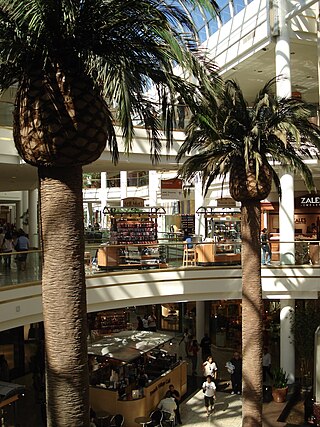
South Bay Galleria, formerly named Galleria at South Bay, is a shopping mall located in Redondo Beach, California, United States. It is anchored by Macy's, Kohl's, Q, Wonder of Dinosaurs, and a 16-screen AMC Theatres multiplex.

May Company California was an American chain of department stores operating in Southern California and Nevada, with headquarters at its flagship Downtown Los Angeles store until 1983 when it moved them to North Hollywood. It was a subsidiary of May Department Stores and merged with May's other Southern California subsidiary, J. W. Robinson's, in 1993 to form Robinsons-May.
Plaza West Covina is a large regional shopping mall in West Covina, California, owned by the Starwood Capital Group. Its anchor stores are Macy's, JCPenney, XXI Forever, Nordstrom Rack, Best Buy, and Gold's Gym with one vacant space last occupied by Sears. Westfield America, Inc., a precursor to Westfield Group, acquired the shopping center in 1998 and renamed it "Westfield Shoppingtown West Covina", dropping the "Shoppingtown" name in June 2005. In October 2013, the Westfield Group sold the mall to Starwood Capital Group and the mall is now managed by Pacific Retail Capital Partners.

The Shoppes at Carlsbad is a shopping mall in Carlsbad, California. The mall was originally named Plaza Camino Real when it was built in 1969, but was rebranded several times when it was a Westfield Holdings property (1994-2015). Its anchor stores are JCPenney and Macy's. A Robinsons-May closed in 2006, while Sears closed on December 15, 2019.
Inland Center is a regional shopping mall owned and operated by Macerich, located in San Bernardino, California along the southwest border adjacent to Interstate 215 and the city of Colton. The mall is within one mile of three bordering cities on the southern end of San Bernardino. Inland Center is a single-level mall anchored by, JCPenney, Forever 21 and Macy's, plus 110 specialty shops and services.
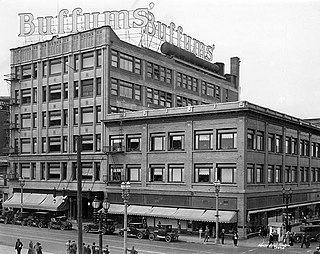
Buffums, originally written as Buffums' with an apostrophe, was a chain of upscale department stores, headquartered in Long Beach, California. The Buffums chain began in 1904, when two brothers from Illinois, Charles and Edwin Buffum, together with other partners, bought the Schilling Bros., the largest dry goods store in Long Beach, and renamed it The Mercantile Co. The store grew to a large downtown department store, and starting in the 1950s, grew slowly over the years to be a small regional chain of 16 speciality department stores across Southern California at the time of its closure in 1990.

The Bloc, formerly Macy's Plaza and Broadway Plaza, is an open-air shopping center in downtown Los Angeles at 700 South Flower Street, in the Financial District. Its tenants include the downtown Los Angeles Macy's store, LA Fitness, Nordstrom Local, UNIQLO, and the Sheraton Grand Los Angeles hotel. The shopping center has its own entrance to the 7th Street/Metro Center station of the Los Angeles Metro Rail system. The Bloc tends to connect the financial, fashion, jewelry, and theater districts and the 7th Street Metro Center Station, meaning where four Downtown Los Angeles lines converge more.

The Fifth Street Store was a major department store in Los Angeles opened in 1905.
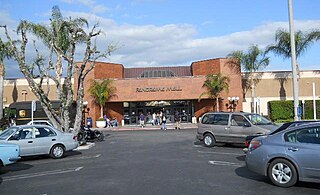
Panorama Mall is a mall in Panorama City, San Fernando Valley, Los Angeles, California. It is an enclosed mall anchored by two large discount stores, Walmart and Curacao, aimed primarily at a Hispanic customer base.

Retail in Southern California dates back to its first dry goods store that Jonathan Temple opened in 1827 on Calle Principal, when Los Angeles was still a Mexican village. After the American conquest, as the pueblo grew into a small town surpassing 4,000 population in 1860, dry goods stores continued to open, including the forerunners of what would be local chains. Larger retailers moved progressively further south to the 1880s-1890s Central Business District, which was later razed to become the Civic Center. Starting in the mid-1890s, major stores moved ever southward, first onto Broadway around 3rd, then starting in 1905 to Broadway between 4th and 9th, then starting in 1915 westward onto West Seventh Street up to Figueroa. For half a century Broadway and Seventh streets together formed one of America's largest and busiest downtown shopping districts.















